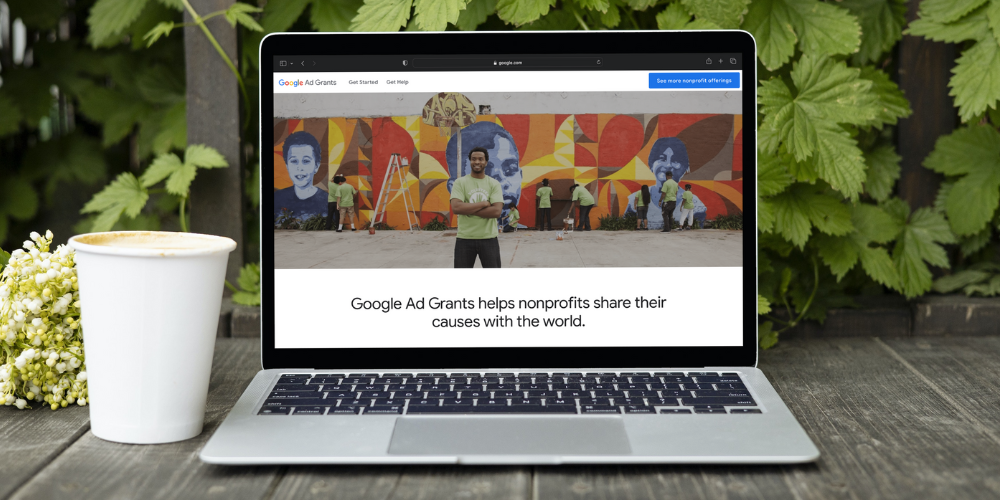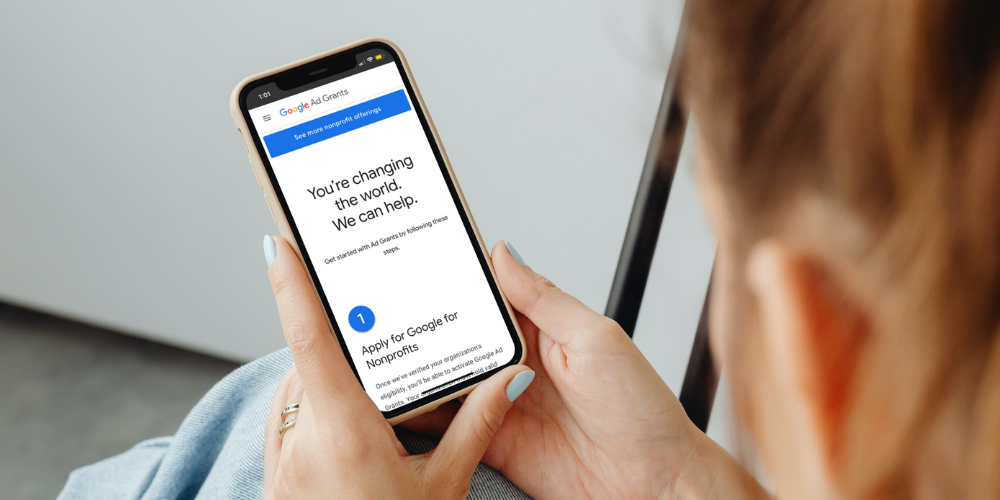
One of the first steps in funding your nonprofit is finding money that’s earmarked for you. You’ve probably already spent plenty of time hunting down and applying for grants, but have you applied for one of the easiest grants to win?
Google Ad Grants is a sure thing if you’re a 501(c)(3) nonprofit and meet a few other requirements. It’s sitting there waiting for you to use it. So start spreading the word about your mission on Google today!
We’re going to break down what Google Ad Grants is, how to apply for it, and then offer a few tips and tricks for maximizing its impact through optimizing keywords and smart bidding strategies.
What is Google Ad Grants and who is it for?
Google Ad Grants gives $10,000 of ad spend each month within Google Ads to 501(c)3 nonprofit organizations.
Thousands of people are likely already searching for keywords that relate to your mission. This is your opportunity to serve FREE ads through Google search to this audience. They're looking for you on Google. Now it's time you appear as a result!
Google is careful to qualify the possible recipients of their grant. You must be a nonprofit organization in good standing, which in the U.S. equates to a 501(c)(3) tax designation. And you must NOT be any of these three:
- A governmental entity or organization
- A hospital or healthcare organization
- A school, academic institution, or university (Although there is a separate program, Google for Education, that you should research instead)
So please don’t waste your time if you’re a government organization, a healthcare organization, or an academic institution.
It may speed up the application process if you already have an account with TechSoup, however, don’t let this step get in the way of your application. You should be fine as long as you have proper documentation of your 501(c)(3) status.
Depending on your country, Google offers additional, specific requirements to ensure that you have all that you need to move forward.
In the United States, this requires the 501(c)(3) status with the IRS, that you are NOT a fiscally sponsored organization, and that if your nonprofit status is through a group exemption that you still maintain individual recognition of your status directly with the IRS.
TechSoup is the organization that Google works directly with to ensure the status of applicants, so this is a way that you can speed up the process — if you login to TechSoup and make sure everything is in order.
How to apply for Google Ad Grants
If you already meet these requirements and haven’t yet applied for Google Ad Grants, please send in your application today! It can take a few weeks for Google to accept your application, so the sooner the better.
There’s $10,000 each month — $120,000 per year — waiting for you to spend on getting the message out!
After signing into Google for Nonprofits, you should be immediately led to an assessment of your organization’s status. It should only take about ten minutes if you have your EIN (Nonprofit ID), physical address, and online contact information on hand. So punch it all in and click submit! Easy!
One additional note: make sure that you use a consistent email from your nonprofit as Google will use this email address as an identifier, linking all your Google tools into one easy-to-use dashboard.
Keys for maximizing Google Ad Grants
I wish I could tell you otherwise, but the easiest part is now over and the real marketing work has just begun. Finding the right key words and competing for words that you can win requires some creativity and research. But again, this is free money, so it’s well worth the time to at least use a majority of this money that’s just begging for you to spend it.
Google reported that the average account spent just over $300 of the $10,000 available. This is a huge loss for nonprofits! So here are a few ways to spend that additional $9,700 per month that so many nonprofits are wasting.
The idea of Google search is to display results (and your ads!) that are relevant for the person searching. This is why it’s essential that when you use Google Ad Grants, you maximize the relevancy of your nonprofit’s ads. If you display ads to people who want to see your ad and then click on it, this is a signal to Google that you’ve set your account up properly.
We’re going to walk through the five steps your organization can take to increase your average monthly spend, which is going to help you bring in new volunteers, donors, and supporters.
1. Set up your Google Ads account right
A lot of success is dependent on the prep work. When you first get into your Google account and begin setting up your campaigns, make sure that you organize your account in a way that aligns with your organization's larger goals. Without clearly defined expectations, it won’t matter if you spend the $10,000 max. So define these goals before you begin running campaigns.
As a nonprofit, you most likely work with volunteers to accomplish much of your work. So a goal may be to recruit 20 volunteers for your upcoming community event.
Or you may be approaching the end of the year, and you’re looking for new donors to bring in $20,000 in year-end gifts. You most likely already have pages on your website built to communicate these needs, so now when you organize your Ads account, you’ll simply be aligning your advertising strategy in Google with your organization’s priorities.
For example, if your website has sections for events, volunteers, and donations, your overall campaign should be one of these larger umbrella categories. Then inside each campaign, you’ll have the opportunity to further break these categories up into ad groups.
For volunteers, you may be looking for help with your accounting but also other volunteers to help paint a house. These unique volunteer opportunities would be the ad groups within the Volunteer campaign.
Once you’ve chosen these ad groups, you’re now approaching the step where you get to choose your keywords — what people are actually searching in Google — and start bidding on those ads.
2. Prepare your website for incoming traffic
But first, before you start running your campaigns, you need to make sure that your website is ready for this traffic.
Picking the winning keywords and bidding correctly will only get you so far. If someone clicks on your ad and gets taken to a page on your website that doesn’t meet their expectation for where they wanted to go, or if they simply land on your homepage, there’s a large chance that the desired action isn't going to happen.
This is why it’s so important to plan where visitors will land. If they click on an ad to volunteer for a specific event, they need to land on a page built specifically for that, ideally with half the sign-up form already auto-filled. The point in preparing your website is to remove all confusion for those who click on your ads.

It would be such a waste to use all that ad spend, but then have nothing to show for it besides a lot of people making it to your website and then leaving. By creating unique landing pages, or sending people to the right pages that you already have within your website, you’re ensuring that your campaign is as effective as it can be.
3. Build that keyword list
Now the real fun has begun. It’s time for you to specify for Google what keyword phrases you want your ads to display for.
First, just a few technical definitions: A keyword is a single word that defines the essential content of a post or webpage. So someone could search for “puppies” or “donations.” But notice that I said keyword phrase above because almost no one simply plugs a single keyword into Google, which is why you’ll be competing for keyword phrases. A lot of people use "keyword" and "keyword phrase" interchangeably, and that's ok, I just wanted to clarify that you're really competing for the phrase.
One thing to keep in mind: because as a nonprofit you don’t typically want to be bidding against the largest corporations, you’ll design your keyword phrases to be longer and more specific. In the search engine optimization (SEO) world, this is called a long-tail keyword. So instead of running an ad for “volunteer recruitment,” which is short tail, it would almost always be more effective to run something more like, “volunteer opportunities at homeless shelters in Alachua county.”
Fewer people are searching for this specific keyword phrase, which means that your ad will be more relevant for those who search for it, and so more likely to be clicked. But then since it is less regularly searched or competed for, you’ll also be able to bid lower and still win. You can spend less and get better results. That's a good deal!
There are tools that will give you an idea of search volume and the difficulty of serving ads for those words. Within Google, you can go to the Keyword Planner, or you can use one of my favorites, Ahrefs free keyword generator, but both these tools will only give you ideas and not definitive answers. This is where creativity and constant optimization comes into play.
The key to building this list is empathizing with searchers. Think about what potential volunteers, donors, and supporters are looking for that would bring them to your door. Instead of relying too heavily on software tools, instead brainstorm a large list of specific phrases and allow the results to inform your direction going forward.
Don’t expect a home run the very first time you swing. Every organization is different, so there isn’t a formula for how people find you. You need to go with your gut and then use what you learn to constantly refine that process. Remember, the $10,000 is there for you to spend, so testing keyword phrases doesn’t cost you a dollar — just a little time and creativity.
4. Bid smart
Google sets a few limits on nonprofit ads accounts so that your spending doesn’t go over the $10,000 limit. Google spells out the specifics here, but what you want to keep in mind is that your entire spend will be capped at $329 per day. It’s been said that Google won’t allow bids higher than $2.00, but this is if set all bids manually. Google recently added the Smart Bidding function, which allows you to exceed the manual limit of $2.00 per bid.
There are two bidding settings that you should immediately adjust if you haven’t already:
- Set all campaigns to a max spend of $329 instead of adding all of your campaigns up to the $329 total. Google will automatically cap your spend for you, so you’re much more likely to spend all of your available budget by giving each campaign more leeway. If you already are spending a large majority of your available funds, then you may consider adjusting your campaigns accordingly and giving priority to the most successful or important current campaigns. So only if you're already maximizing spend should you start bringing these campaign budgets below that magic number: $329.
- Begin using Smart Bidding instead of manual bidding. Google suggests using the Maximum conversion values option if you’re tracking donations, purchases, or memberships and the Maximize conversions option if you’re tracking anything else. This will allow you to bid higher for those important placements, but it will also make your bidding more effective in general.
5. Constantly improve
We mentioned this in the keyword section, but it’s so essential in marketing and advertising to try new ideas and learn from failures and successes. I would be astounded if you spent $10,000 the first month that you jumped into Google Ad Grants. But spending a majority of that grant over the course of a year is realistic if you manage your account well and learn from the campaigns that are performing less than or above average.
Ad copy, keywords, and landing pages are meant to evolve. Everything in life changes, and trying new things is essential for making the most of each moment.
Because one phrase worked doesn’t mean it’s always going to work, and just because one phrase didn’t work the first time, doesn’t mean there isn’t something left to do with it.
Putting it all together
The real trick here is to get out there and start playing! Nobody becomes a pro overnight, but by taking a step at a time, you’ll be able to use more and more of your Google Ad Grant to bring your nonprofit new volunteers, donors, and supporters.
We want you to succeed in all your marketing efforts because we want you to be able to do just a little more good in the world.
For-profit companies are spending a lot of money to be heard, and Google is doing an amazing thing by allowing nonprofits into a space that they may not have been able to get into otherwise. So make the most of it and continue to tell the world about the amazing work you're up to!
You May Also Like
These Related Stories

Maximizing your nonprofit’s budget with cost-effective ads

Boost your nonprofit's reach with search-based targeting
